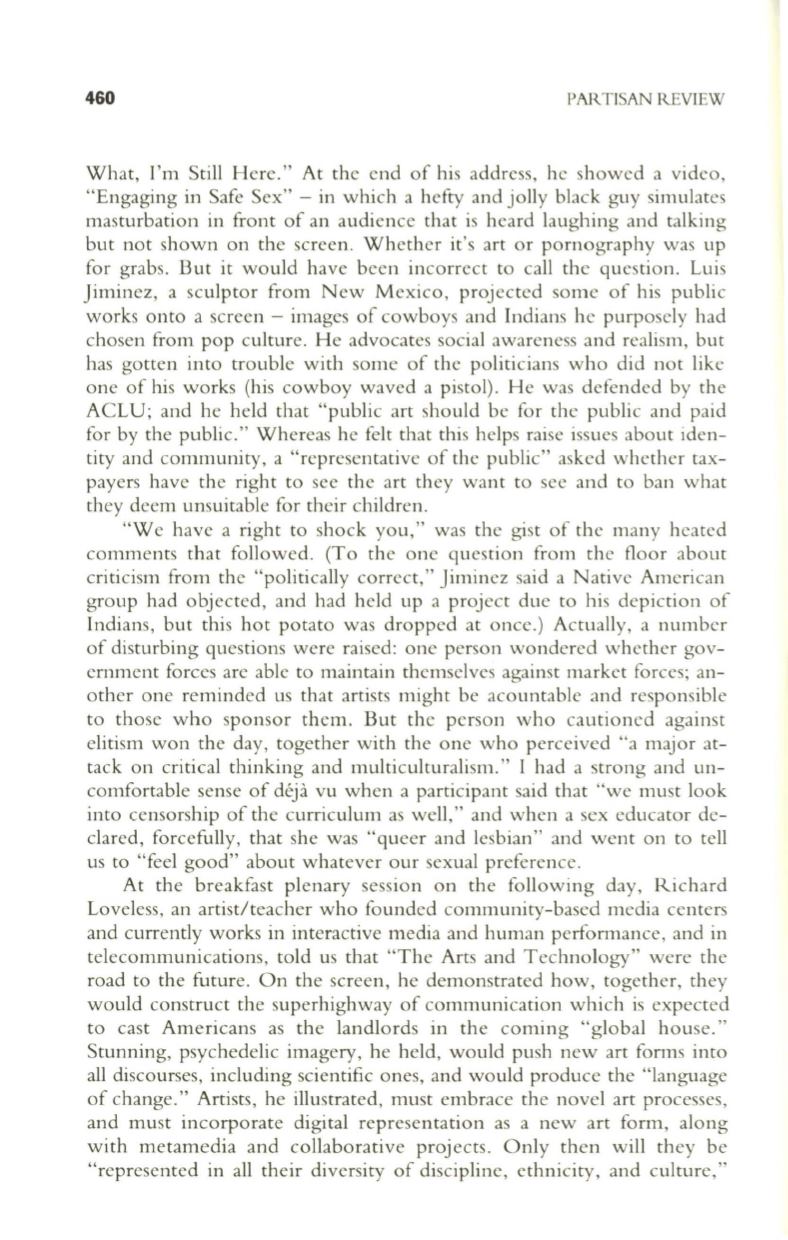
460
PARTISAN REVIEW
What, I'm Still Here ." At the end of his address, he showed a
video,
"Engaging in Safe Sex" - in which a hefty and jolly black guy simulates
masturbation in front of an audience that is heard laughing and talking
but not shown on the screen. Whether it's art or pornography was up
for grabs. But it would have been incorrect to call the question. Luis
Jiminez, a sculptor from New Mexico, projected some of his public
works onto a screen - images of cowboys and Indians he purposely had
chosen from pop culture. He advocates social awareness and realism, but
has gotten into trouble with some of the politicians who did not like
one of his works (his cowboy waved a pistol). He was defended by the
ACLU; and he held that "public art should be for the public and paid
for by the public." Whereas he felt that this helps raise issues about iden–
tity and community, a "representative of the public" asked whether tax–
payers have the right to see the art they want to see and to ban what
they deem unsuitable for their children.
"We have a right to shock you," was the gist of the many heated
comments that followed. (To the one question from the floor about
criticism from the "politically correct," Jiminez said a Native Ameri can
group had objected, and had held up a project due to his depiction of
Indians, but this hot potato was dropped at once.) Actually , a number
of disturbing questions were raised: one person wondered whether
gov–
ernment forces are able to maintain themselves against market forces; an–
other one reminded us that artists might be acountable and responsible
to those who sponsor them. But the person who cautioned against
elitism won the day, together with the one who
perceived
"a major at–
tack on critical thinking and multiculturalism." I had a strong and un–
comfortable sense of deja
vu
when a participant said that "we must look
into censorship of the curriculum as well," and when a sex educator de–
clared, forcefully, that she was "queer and lesbian" and went on to tell
us to "feel good" about whatever our sexual preference.
At the breakfast plenary session on the following day, Richard
Loveless, an artist/teacher who founded community-based media centers
and currently works in interactive media and human performance, and in
telecommunications, told us that "The Arts and Technology" were the
road to the future. On the screen, he demonstrated how, together, they
would construct the superhighway of communication which is expected
to cast Americans as the landlords in the coming "global house."
Stunning, psychedelic imagery, he held, would push new art forms into
all discourses, including scientific ones, and would produce the "language
of change." Artists, he illustrated, must embrace the novel art processes,
and must incorporate digital representation as a new art form, along
with metamedia and collaborative projects. Only then will they be
"represented in all their diversity of discipline , ethnicity, and culture,"


